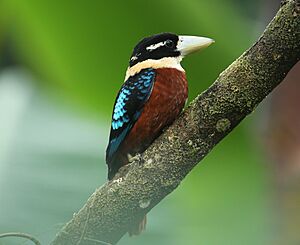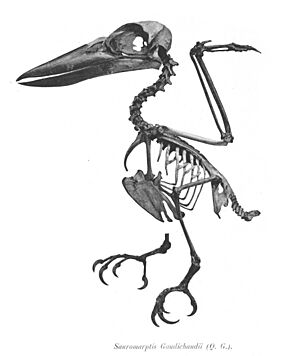Rufous-bellied kookaburra facts for kids
Quick facts for kids Rufous-bellied kookaburra |
|
|---|---|
 |
|
| Conservation status | |
| Scientific classification |
The rufous-bellied kookaburra (Dacelo gaudichaud) is a special type of kookaburra. It was first named after a French botanist, Charles Gaudichaud-Beaupré. This bird lives in the thick forests of lowland New Guinea.
Contents
What Does It Look Like?
The rufous-bellied kookaburra has a black cap on its head. Its wings have a blue tint, and its belly and tail feathers are a pale reddish-brown color. A key feature is its white bill, which helps tell it apart from other kookaburras that have black bills.
Young kookaburras, called juveniles, have a dark-grey bill. You can tell male and female rufous-bellied kookaburras apart by their tail feathers. Males have blue tails, while females and young birds have reddish-brown tails.
Size of the Rufous-bellied Kookaburra
These kookaburras are smaller than their relatives. They weigh about 143 grams (5 ounces). They are also about 28 centimeters (11 inches) long. For comparison, the well-known laughing kookaburra is much bigger. It weighs around 335 grams (12 ounces) and is about 46 centimeters (18 inches) long.
Where Do They Live and How Do They Behave?
Unlike most kookaburras, which prefer open areas, the rufous-bellied kookaburra lives in dense rainforests. They do not live in large family groups. Instead, they live alone or in pairs when they are ready to have babies.
You can often find these birds in the middle part of the tropical rainforest. They fly quickly from their resting spots to catch large insects from trees. Even though the forest is thick, they are very good at twisting and turning around trees.
Hunting Habits
Rufous-bellied kookaburras mostly eat large insects. They also sometimes hunt small animals with backbones, like tiny lizards. However, they do this less often than bigger kookaburras. Smaller birds sometimes bother them if they try to eat their eggs or baby birds.
Male kookaburras are very protective of their homes. Their territory is usually about 2 to 2.5 hectares (5 to 6 acres) in size. They can be quite aggressive and sometimes fight other kookaburras that enter their space.
Reproduction and Life Cycle
Like their larger relatives, rufous-bellied kookaburras build their nests in termite mounds. They usually lay eggs between May and October. The young birds stay with their parents until February. These kookaburras typically have only one group of babies each year.
A female kookaburra will lay two white eggs. We do not know exactly how long it takes for the eggs to hatch.



